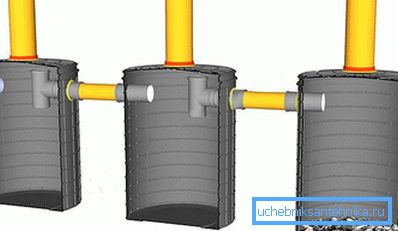Septic tank from barrels in the country itself: instructions
The use of expensive factory-made septic tanks in summer cottages, which are operated only during the summer period, is not economically feasible. That is why the majority of owners of suburban buildings would like to use a more affordable way of arranging the sewage treatment plant, not associated with tangible cash costs.
As one of the possible solutions to this problem, we suggest you try to make a septic tank of plastic barrels with your own hands, using for these purposes unnecessary containers of a suitable volume. Immediately make a reservation that the use of such a design is possible only with a limited amount of waste generated by collecting wastewater from summer baths and other temporary structures.
Installation of sewage treatment plant
Location Requirements

Tip! When choosing a place, you should be guided by the requirements of sanitary standards, which stipulate its minimum distance from wells and wells with drinking water, as well as from the foundations of nearby buildings.
Regarding the capacity of the composite construction, the following should be noted. In the event that no more than 3 people live at the dacha in the summertime - 2 or 3 plastic barrels with a total capacity of at least 250 liters are enough for arranging a septic tank. In the process of assembling the septic tank, the containers placed in one line are interconnected by means of small overflow pipes placed in specially prepared mounting holes. When installing them, it is necessary to take into account that the outlet pipe should be located approximately 10 cm below the inlet (intake) opening. To do this, each subsequent tank should fall into the ground 10? 15 cm deeper than the previous one (step arrangement in height).

In the construction under consideration, the first two hermetic tanks will be used as a settling tank, while the third barrel (with the bottom removed) will serve as a drainage well, in which natural filtration of the settled effluent is carried out. Under the settling tanks, it will be necessary to prepare a well-compacted sand cushion with a thickness of about 10 cm. A 50-cm layer of sand is poured under the third chamber of the structure used as a drainage well. The sand-gravel filter is managed from above with a layer of crushed stone. to organize additional treatment of wastewater, absorbed into the ground.
Tip! Instead of the third barrel, you can make the filter field.
Consumables

Building materials required:
- fine grained crushed stone;
- the cloth is geotextile;
- two plastic containers of 250 l;
- billet pipes with a diameter of 110 mm;
- connecting elements (tees, angles, couplings, flanges);
- perforated pipes used for drainage;
- special glue for PVC materials;
- epoxy sealant.
Necessary tool

As for the tool for the production of works, then you will need to prepare:
- building level;
- simple bayonet spade;
- electric jigsaw.
Work order

Works on the arrangement of a septic tank should be carried out in a strictly defined sequence:
- First of all, in prepared barrels with an electric jigsaw, holes are cut to the size corresponding to the diameter of the overflow and drain pipes. The location of the pipe inlet is selected at some distance (about 20 cm) from the upper cutoff of the container. The outlet in each of the chambers is on its opposite side 10 cm below the inlet.
- Billets are installed in the prepared holes, after which the formed joints are filled with epoxy sealant.
- After that, in the first barrel settles ventilation riser used for removal of gases.
- At the bottom of the second tank, which serves as a settling tank, two holes are made at an angle of 45 degrees, to which drainage pipes are then connected.

In conclusion - a few words about the preparation of the pit under the septic tank. The multistage bottom of the excavated trench is thoroughly leveled and covered with a layer of sand with a thickness of about 10 cm, followed by ramming. The barrels prepared in this way fit the barrels, after which all the free spaces are filled with a mixture of cement and sand, carefully tamping down each new layer of backfill. As the backfill of the excavation pit is drilled, it will be necessary to fill it with water (to compensate for the pressure on the walls from the side of the mixture being laid).
Upon completion of work with a septic tank, at a short distance from it, a trench of about 60–70 cm in depth is prepared, used for laying drainage pipes. The walls and bottom of this trench are closed with geotextile fabric, after which the pipes laid on its bottom are covered with the same fabric and covered with rubble.